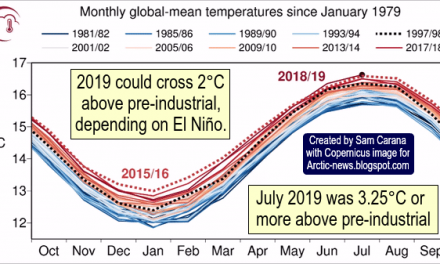Written by Bruce Melton / Truthout
New earthshaking science will be coming out in the 2021 Intergovernmental Panel on Climate Change (IPCC) report that could nearly double future warming predictions. We have a window into this new science now, and if we thought the spate of apocalyptic climate reports last year was bad, our near-term future will create a plausible scenario that is far worse than the worst-case scenario we have come to fear.
If we don’t get our collective climate acts together immediately, what will our future look like when warming is near double the astonishing impacts we have already been told to expect? How are we going to stop this future calamity?
Doubt, delay and inaction continue. Unprecedented firestorms, floods, droughts and hurricanes strengthen nonlinearly because of small amounts of additional warming. Abrupt Earth system collapses are completing their initiations and becoming unrecoverable. Most concerning is something brand new — something climate science has been puzzling over for 30 years.
Most of us have heard that we have 12 years to fix climate change. This 12-year time frame is what we have left to get our greenhouse gas emissions budget under control, and to meet a target of returning to and staying at 1.5 degrees Celsius (1.5°C) of warming. It requires we follow a path of emissions reductions where we reduce carbon dioxide (CO2) levels about 45 percent below 2010 levels by 2030. The rest of the emissions reduction path varies a bit depending on how much CO2 we actively remove from the atmosphere, and includes zero CO2 emissions by 2050. So based on this pathway, we have delayed so long that we have only 12 years to succeed or fail. Failure is poorly defined, but a recent article in The Guardian does a pretty good job of describing failure as “render[ing] the planet unrecognizable from anything humans have ever experienced.”
Embedded in The Guardian article is an editorial in the journal Science on the new climate modeling to be presented by the IPCC report due out in April 2021 that will likely rock the climate culture world. This article is in one of the most prestigious science journals on the planet. What it is saying is that our climate future, not to mention our current time, is turning out to be much worse than has been previously projected.
The new science that so radically increases danger over what we thought was radically dangerous before includes more modeling institutions, more models, more experiments and more data. It is now 65 percent complete. Final results will include up to 50 petabytes of results. How big is a petabyte? It would take 170 years of watching back-to-back HD movies for 365 days a year and 24 hours a day to equal 50 petabytes of information.
The buzz on this new modeling is about climate sensitivity. Climate sensitivity is how much Earth warms with a doubling of CO2 in our atmosphere, or what warming to expect when all Earth systems come into balance with 560 parts per million (ppm) CO2 — whenever this happens. Climate sensitivity then is an arbitrary amount of warming that is double the 280 ppm CO2 when we first started burning fossil fuels. It is so important because it is a basic parameter of climate modeling. All warming in climate models is fundamentally based on the climate sensitivity of the model. Incidentally, CO2 peaked at about 410 ppm CO2 last year.
Climate sensitivity includes not only warming from CO2, but warming from other greenhouse gases, as well as warming from things like changes in agriculture and forestry practices or in snow cover that allows more heat to be absorbed by water, plants and soil, and not reflected harmlessly back into space by the whiteness of snow and ice.
Climate sensitivity in the 2007 IPCC report was 2-4.5°C. In the latest IPCC climate sensitivity report in 2013, this changed slightly to 1.5-4.5°C. Both give a best estimate of basically 3°C. Of the new modeling, preliminary results show eight out of the 13 models, with this latest most robust round of modeling ever coming in with a best estimate of 5°C or more climate sensitivity — an astonishing finding that modelers are challenged to explain.
The models were all developed separately to take advantage of new and much more accurate Earth data. The work is so new, the developers really don’t have a handle on exactly why the heating is so much greater with the new models, but all the models agree. The reason for the jump likely lies in advancements in climate science over the last decade that have allowed new data to be collected in amounts far surpassing anything before, and in the increased complexity of modeling made available by the latest superfast supercomputers.
The new modeling addresses holes in our data from the past, like how clouds form and respond to a changing climate, which clouds reflect and which absorb sunlight, where they change, and what difference this makes with the global temperature. What all of this new detail means is that heating will plausibly happen nearly twice as fast as what has been projected for decades.
The challenge remains very complicated, and in the future, when we have even more data and even better models, things could (and likely will) change again. The plausible future changes in themselves are quite troubling, as the predominant way that future climate projections have changed in the past is that previous results have largely been found to be understated.
These understatements revolve around climate modeling. But it’s not clouds or how things on Earth reflect sunlight back into space. This is about abrupt climate changes, or Earth systems’ tipping points or thresholds.
Scientists are beginning to use a new term for these tipping points and threshold discussions. It has more meaning to us civilians and will hopefully get the word across in a more effective way. The term is “point of no return.”
We hear about these things and fundamentally we understand what they are. The biggest and most reported is the collapse of the West Antarctic Ice Sheet. We know it happened in prehistory when Earth’s temperature was similar to what it is today, and we know it happened in astonishingly short time frames.
Today, however, carbon dioxide in our atmosphere is rising 100 times faster than at any time in prehistory, except maybe that time when the giant asteroid hit the Yucatan Peninsula and the dinosaurs went extinct. To expect the latest, more extreme modeling will revert back to less extreme results is not too likely.
Time is short. It’s likely even shorter than we understood with the latest round of apocalyptic climate reports in 2018. How we as a global society behave in the very near term will likely decide the future. The 12-year time frame to act is now likely shorter.



